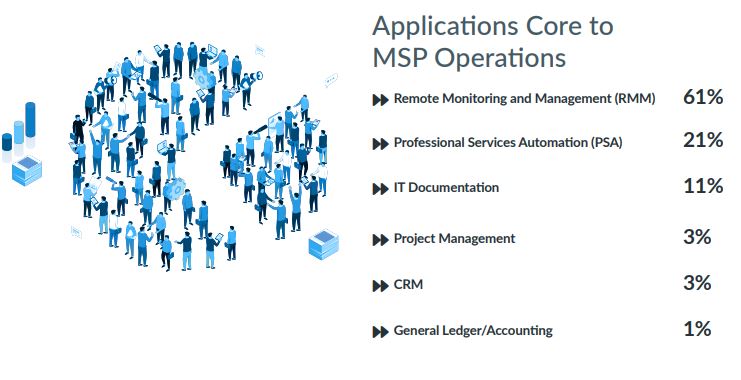It’s a tough market out there for IT managed service providers (MSPs). The COVID-19 pandemic has caused an onslaught of demands from MSP customers that have been forced to transform their businesses to accommodate a remote workforce and/or are facing dramatic revenue declines. Simply staying in business in the current economic environment can be challenging.
MSPs rely on their remote monitoring and management (RMM) software to provide effective IT services to their clients. In fact, the Kaseya 2020 MSP Benchmark Survey Results Report shows that 61 percent of MSPs say that RMM software is a core application for running their business.

While most MSPs use commercial RMM solutions, some MSPs have opted to use open source RMM tools. But can these free tools provide you with what you need in the long term? In this blog, we’ll take a brief look at the advantages and disadvantages of free, open source RMM tools and commercial tools.
Paid vs. Free Commercial Tools vs. Free Open Source RMM Tools
In the MSP market, there are two types of RMM tools – paid (i.e., commercial products) and free. The latter can be either open source or free versions of commercial products. Generally, paid tools provide most or all of the functionality required to monitor and manage your clients’ IT infrastructure. The paid tools will also usually scale up to a reasonable number of endpoints, but this can vary widely across different products.
Free commercial RMM tools typically have either limited and basic functionality or are limited in terms of the number of endpoints you can manage. A few free, commercial RMM tools, such as Comodo ONE, Spiceworks and Manage Engine Desktop Central MSP, do provide functionality such as patch management, service desk, 24*7 support, onboarding and configuration, and have free subscriptions, but only up to a certain number of endpoints. And this endpoint limit is pretty small —on the order of 25 endpoints in some cases.
Open source RMM tools may also have somewhat basic functionality. A key area of concern would be support for more advanced IT automation capabilities. Another major drawback of free, open source RMM tools is the general lack of support. If your open source RMM tool has a major bug, who is going to fix it for you?
These free RMM tools, whether commercial products or open source, are best suited for smaller MSPs that manage a very small number of endpoints and provide limited IT services. Open source RMM tools could be a good solution for MSPs that are just starting out. There are no software licensing fees and maintenance costs associated with open source RMM software. So initially, MSPs need not invest heavily in procuring RMM software to manage their first couple of clients. The lack of advanced automation is also not likely to be a big issue during the early days since the number of endpoints under management is small.
Paid RMM Tools for More Mature MSPs
“You get what you pay for” is aptly applied to an effective RMM solution. As MSPs grow, so does their infrastructure, their clients’ infrastructure and the needs associated with efficiently managing that infrastructure. An efficient, paid RMM solution allows MSPs to keep customers happy by enabling MSPs to maintain system uptime and security through automated maintenance and incident remediation processes, for example. Scalability is key as well.
- Can be easily deployed across many endpoints and scaled up as required
- Provides automated software update and patch management capabilities
- Monitors IT endpoints in real time, alerts on any issues and auto-remediates common issues
- Allows easy remote access (remote monitoring and management) for quick troubleshooting of issues
- Automates a wide range of IT processes to increase IT operational efficiency (and increase the endpoint-to-technician ratio)
- Generates robust reports for client consumption
However, MSPs should exercise caution while adopting an RMM tool, or they could get stuck with a paid solution for a contracted period, even if they find it unsuitable for their business.
Free RMM or Paid RMM – Efficient IT Management Is the Key to MSP Success
Whether you are a newbie in the MSP industry or a mature business that has seen all the high and lows of the MSP market, choosing an RMM tool isn’t an easy decision. RMM lays the foundation for your success, which is why it doesn’t pay to skimp on the solution.
Look for a tool that suits your business requirements and streamlines the process of monitoring and managing your clients’ infrastructure. Deploying, learning or configuring any new tool, even free RMM software, requires significant time. It is advisable for MSPs to conduct some sort of trial before they invest in a solution on a long-term basis.
Kaseya VSA, a powerful RMM solution, enables MSPs to efficiently deliver high-quality IT services and grow their business in the most cost-effective way. Request a demo of Kaseya VSA to learn more.


